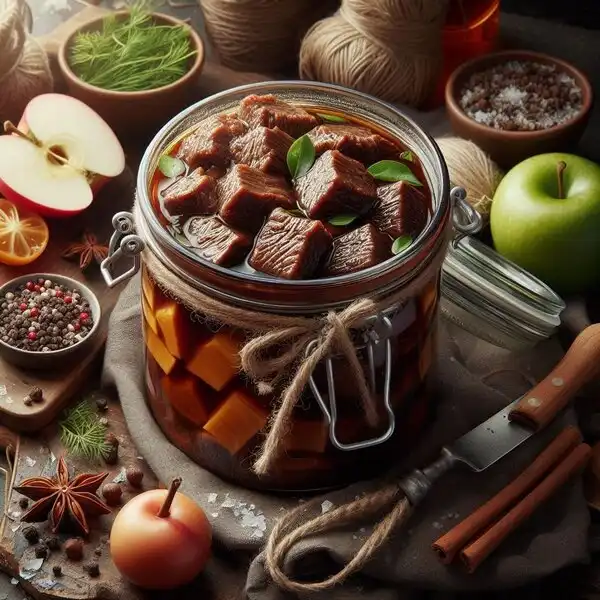Effortless Beef Stew Canning: Your Complete Guide
Mastering Homemade Convenience
Canning beef stew offers a simple way to create delicious and convenient meals right from your pantry. With a few easy steps, you can have ready-to-eat stew whenever you need it, saving time and effort on busy days.
Adaptable Meat Choices
One of the great advantages of canning beef stew is its flexibility. You can use various meats like beef, venison, lamb, or pork, depending on your preferences and what you have available. This versatility allows you to customize your stew to suit your taste.
Simplified Pressure Canning
While pressure canning may seem intimidating at first, it's actually a straightforward process. By demystifying the use of pressure canners, you'll gain the confidence to safely and efficiently preserve your beef stew at home. With the right guidance, you'll soon discover how easy it is to enjoy homemade convenience meals anytime.

Optimizing Flavor and Texture: Raw vs. Hot Pack
Weighing Your Options
When it comes to canning beef stew, one of the key decisions you'll need to make is whether to use the raw pack or hot pack method. Both methods have their advantages, so it's essential to understand the differences before proceeding.
- Raw Pack: In the raw pack method, you add raw meat and vegetables directly into the jars before canning. This method is preferred by some as it preserves the texture of the ingredients better compared to the hot pack method.
- Hot Pack: With the hot pack method, you precook the stew before canning it. This process involves simmering the stew ingredients together for a short period before transferring them into jars. While this method requires more preparation time, some argue that it results in a more flavorful end product.
Enhancing Taste and Quality
Regardless of which method you choose, it's crucial to consider how it will impact the taste and quality of your canned stew. The raw pack method tends to produce a stew with firmer vegetables and meat, while the hot pack method can yield a softer, more melded texture.
TIP: Store leftovers in airtight containers and label them with dates to keep track of freshness and reduce food waste.
Experimenting with both methods can help you determine which one aligns best with your preferences. You may find that certain ingredients or recipes lend themselves better to one method over the other.
Ensuring Safe Canning Practices
Whichever method you opt for, safety should always be a top priority when canning beef stew. Ensure that you follow proper canning procedures, including using clean jars, lids, and equipment, as well as adhering to recommended processing times and pressure levels.
By understanding the differences between raw pack and hot pack methods and following safe canning practices, you can confidently create delicious and shelf-stable beef stew that will be enjoyed for months to come.
Streamlined Canning Process: Step-by-Step Guide
Efficient Preparation Techniques
Before diving into the canning process, it's essential to ensure that you have all the necessary equipment and ingredients on hand. Start by gathering your canning jars, lids, and bands, ensuring they are clean and in good condition. Additionally, prepare your meat, vegetables, and any desired seasonings according to your recipe.
Organize your workspace to streamline the canning process. Set up your pressure canner and begin heating the water while you pack your jars with the stew ingredients. Having everything prepared in advance will help make the canning process more efficient and enjoyable.
Flavorful Seasoning Ideas
One of the joys of homemade canned stew is the ability to customize the flavor to your preferences. Experiment with various seasoning combinations to create a stew that suits your taste buds. Consider adding herbs like thyme, rosemary, or bay leaves for a fragrant aroma and depth of flavor.
- Salt and Pepper: Start with the basics by seasoning your stew with salt and pepper to enhance its overall taste.
- Garlic and Onion: Add depth to your stew with the aromatic flavors of garlic and onion. Sauté them before adding them to the stew for a richer taste.
- Spices: Elevate your stew with a hint of spice using ingredients like paprika, cumin, or chili powder. Adjust the amount according to your preference for heat.
Proper Sealing and Storage
After filling your jars with stew and securing the lids, it's time to process them in the pressure canner. Follow the manufacturer's instructions for your specific canner, ensuring that the pressure and processing time are correct for your altitude. Once the processing is complete, carefully remove the jars from the canner and place them on a towel-lined surface to cool.
Once cooled, check the seals on your jars to ensure they are airtight. Any jars with compromised seals should be refrigerated and consumed promptly. For the remaining jars, remove the bands, wipe them clean, and store them in a cool, dark place for optimal shelf life. Properly canned beef stew can last for up to a year, providing you with convenient and delicious meals whenever you need them.
Expert Tips and Common Mistakes
Avoiding Pitfalls
While canning beef stew is a rewarding process, there are common mistakes to avoid to ensure the best results. One common pitfall is not following proper canning procedures, which can lead to safety issues and compromised quality. Always use tested recipes and reliable canning methods to minimize the risk of foodborne illnesses.
Another mistake to avoid is overfilling or underfilling your jars. Overfilling can lead to improper sealing, while underfilling may result in excess air in the jar, leading to spoilage. Follow the recommended headspace guidelines provided in your canning recipe to achieve the perfect balance.
- Check for Air Bubbles: Before sealing your jars, use a non-metallic utensil to remove any air bubbles trapped in the stew. This step ensures proper packing and helps prevent potential spoilage.
- Monitor Processing Time: It's crucial to adhere to the recommended processing time and pressure for your altitude when using a pressure canner. Processing for too short a time can result in underprocessed food, while overprocessing can lead to mushy texture and loss of flavor.
- Inspect Seals: After the jars have cooled, check the seals to ensure they are tight and concave. Any jars with compromised seals should be refrigerated and consumed promptly.
Join Our Community
Connect with a community of fellow homesteaders to share experiences, tips, and resources for successful canning endeavors. Joining a community provides valuable support and insights, whether you're a novice or seasoned homesteader.
By engaging with like-minded individuals, you can learn from their experiences, troubleshoot challenges, and discover new techniques to improve your canning skills. Whether it's through online forums, social media groups, or local meetups, the homesteading community offers a wealth of knowledge and camaraderie.
Stay Updated
Sign up for our newsletter to receive weekly tips, updates, and exclusive content to enhance your homesteading journey. Stay informed about the latest trends, recipes, and safety guidelines to ensure success in your canning and homesteading endeavors.
Our newsletter delivers valuable insights straight to your inbox, keeping you up-to-date with the ever-evolving world of homesteading. Don't miss out on the opportunity to expand your knowledge and skills – sign up today!

 Emma
Emma

